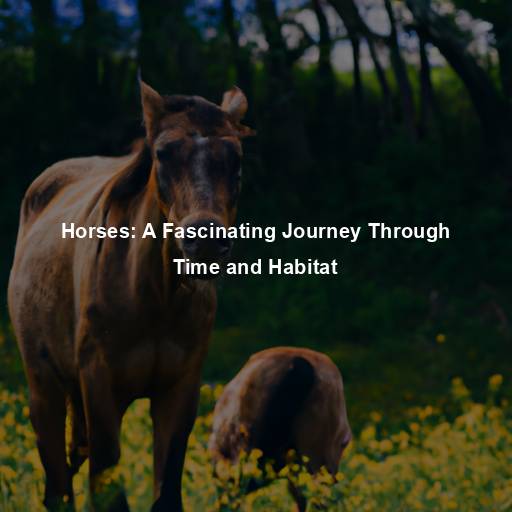Horses: A Fascinating Journey Through Time and Habitat
Last Updated on October 25, 2023 by Evan
Contents [hide]
- 1 The Wonders of Horses: A Brief
- 2 The Native Habitats of Horses
- 3 Adaptations to Diverse Habitats
- 4 Horses Today: A Global Presence
- 5 Unveiling the Mysteries of Horse Habitat
- 6 The Enduring Bond Between Humans and Horses
- 7 Preserving Horse Habitats: A Call to Action
- 8 FAQs: What are horses native to?
- 8.1 What is the native habitat of horses?
- 8.2 Are horses native to North America?
- 8.3 Where else can horses be found in the wild?
- 8.4 Can horses adapt to different environments?
- 8.5 How did horses spread to different continents?
- 8.6 Are all horse breeds native to their respective countries?
- 8.7 Do horses exist in the wild today?
The Wonders of Horses: A Brief
Horses, majestic creatures that have captivated humans for centuries, hold a special place in our hearts. Their strength, grace, and loyalty have made them invaluable companions throughout history. But have you ever wondered where horses originated from? In this article, we will embark on a fascinating journey through time and explore the native habitats of horses, shedding light on their evolutionary journey and the diverse landscapes they once called home.
The Ancient Origins of Horses
Journeying into the depths of horse ancestry requires a captivating expedition through the corridors of time. Casting our gaze back to the primordial beginnings, we encounter the awe-inspiring Equus caballus, known to us as horses. Forged in the crucible of evolution, these magnificent creatures trace their lineage an astonishing 55 million years to a diminutive predecessor, the Eohippus. This enchanting creature once roamed the verdant landscapes of ancient North America, back when the Eocene epoch held sway over the Earth’s bosom.
The Native Habitats of Horses
North America: The Birthplace of Equids
As horses evolved, their habitats expanded across different continents. The first true horses, known as equids, emerged in North America around 4 million years ago. The grassy plains and open woodlands of this region provided the perfect environment for these early equids to thrive. They roamed freely, grazing on the abundant grasses and taking refuge in the surrounding forests.
Eurasia: The Spread of Equids
Throughout the ages, an extraordinary journey unfolded as horses embarked on an epic migration across ancient land bridges, gradually conquering untamed territories and forging an indelible connection with the sprawling landscapes of Eurasia. This awe-inspiring continent, with its mosaic of breathtaking habitats, became both an irresistible challenge and a promising haven for these majestic creatures, propelling them to adapt and thrive in unimaginable ways. From the stark, icy realms of Siberia to the windswept, sun-baked steppes of Central Asia, horses left their hoofprints of resilience and endurance on every terrain they conquered, evoking wonder and fascination in the hearts of all who witnessed their remarkable odyssey.
The Steppes: A Horse’s Paradise
One of the most significant habitats for horses throughout history has been the Eurasian steppes. Stretching from Eastern Europe to Central Asia, these vast grasslands provided horses with ample grazing opportunities and the freedom to roam in large herds. The steppes became a paradise for horses, shaping their physical characteristics and social behavior.
The Americas: Horses Return Home
Interestingly, horses disappeared from their native North America around 10,000 years ago. It wasn’t until the 15th century that horses made a triumphant return to their ancestral homeland. European explorers, such as Christopher Columbus, reintroduced horses to the Americas during the age of colonization. This reintroduction forever altered the landscapes and cultures of the New World.
Adaptations to Diverse Habitats
Evolutionary Changes: Shaping the Horse
Over countless generations, horses have navigated an intricate web of survival challenges, sculpting their very being to fit the intricate tapestry of their surroundings. Nature’s hand delicately caressed their evolution, favoring the growth of elongated limbs, sturdy hooves that defied the boundaries of terrain, and robust dentition to conquer even the hardiest of flora. Through these extraordinary adaptations, horses have not just endured, but flourished in a kaleidoscope of habitats – be it the boundless plains or the unyielding embrace of mountains.
Social Structures: Strength in Numbers
The untamed landscapes that serve as the backdrop for horses’ existence had a profound impact on their intricate social dynamics. Thriving in the vast expanse of grasslands, these majestic creatures developed an innate inclination to forge communal connections within herds. The symbiotic relationship between herd mates not only fortified their defense against lurking predators but also played a pivotal role in the perpetuation of their species. The interconnectedness and unity among these magnificent beasts ultimately paved the way for their extraordinary survival and the continuation of their lineage in the face of adversity.
Feeding Habits: From Grazers to Browsers
The enchanting landscapes that horses call home have intricately shaped their culinary preferences. Thriving in expansive grasslands, these majestic creatures have evolved into skilled grazers, indulging in the lush blades of grass that blanket the earth beneath them. On the other hand, when navigating through verdant woodlands, they developed an innate ability to navigate a diverse menu, delicately savoring leaves and shrubs, enriching their diet and bolstering their resilience in the face of unforgiving winters and parching droughts.
Horses Today: A Global Presence
Domestication: A Profound Impact
Throughout the vast expanse of history, an extraordinary event unfolded, birthing an intimate alliance between Homo sapiens and the majestic equine species. A transformative milestone etched its mark, spanning millennia, as horses relinquished their untamed solitude to join forces with humanity. Eternally transformative, they galloped through the tapestry of time, becoming vital conduits of movement, growth, and conflict, forever reshaping the intricate web of human existence. Today, their hoofprints trace the globe, traversing unfathomable terrains and fulfilling an array of roles, an ever-present enigma amidst the bewildering tapestry of our planet.
Conservation Efforts: Preserving Native Breeds
Despite their global presence, several native horse breeds still exist today, carrying the genetic legacy of their ancestors. Conservation efforts are underway to protect and preserve these remarkable breeds, ensuring that their native habitats and unique characteristics are safeguarded for future generations to appreciate and cherish.
Unveiling the Mysteries of Horse Habitat
As we delve into the captivating world of horses, it becomes clear that their physical characteristics, social dynamics, and dietary preferences have been intricately shaped by the landscapes they call home. From the lush meadows of North America to the sprawling grasslands of Eurasia, these majestic beings have triumphed over a diverse range of terrains. By unraveling the origins and habitats of horses, we not only gain a profound respect for their awe-inspiring existence, but we also realize the paramount significance of safeguarding their genetic variability and preserving their natural environs.
As we reflect on the magnificence of horses, it becomes clear that their presence in our lives transcends mere companionship or transportation. These awe-inspiring creatures have, throughout history, woven their narratives into the very fabric of our existence. From their gallant gallops to their unwavering loyalty, horses have become emblematic of a timeless bond between humans and animals, evoking a sense of wonder and admiration. Today, let us take a moment to truly appreciate these majestic beings, for they have not only stood the test of time but have also enriched our human experience in countless ways.
Partners in Progress: Horses and Humans
Throughout history, horses have played a pivotal role in human progress and development. From ancient civilizations to modern societies, horses have been trusted companions, aiding humans in various endeavors. They have been instrumental in transportation, agriculture, communication, and even warfare. The bond between horses and humans is a testament to the mutual trust and reliance that has developed over centuries.
The Age of Exploration: Horses and New Horizons
In an era defined by audacious exploration, the majestic presence of horses assumed an indispensable role, captivating the imaginations of intrepid European explorers. As they embarked on treacherous odysseys, these brave souls were overtaken by a profound reliance on these noble creatures. With untamed frontiers beckoning, the gallant horses carried their riders across boundless oceans and into enigmatic realms, their hooves stirring up a whirlwind of wonder and trepidation. Amidst this unfolding drama of discovery, the arrival of horses on the American continent ushered in a profound metamorphosis in indigenous cultures, irrevocably transforming the very fabric of the New World.
Industrial Revolution: The Rise of Horse-Powered Machinery
The winds of change swept through human civilization with the advent of the Industrial Revolution, a time that brought forth an enigmatic shift that forever altered the course of history. Amidst this perplexing transformation, it was the noble equines who gallantly took center stage, their blazing hooves propelling the wheels of progress. Casting their mighty shadows upon mills, carriages, and plows, these majestic creatures breathed life into the realm of agriculture and transportation, their robust strength and unwavering endurance rendering them irreplaceable in the arduous task of hauling burdens and fueling the engines of early innovation.
The Enduring Bond Between Humans and Horses
Companionship and Therapy: Horses as Emotional Support
Beyond their practical contributions, horses have also provided emotional support and therapy to humans. Equine-assisted therapy has gained recognition as a powerful tool for individuals with physical, emotional, or cognitive challenges. The calm and gentle nature of horses creates a nurturing environment where individuals can develop self-confidence, improve communication skills, and foster a sense of connection.
Sports and Recreation: Horses as Athletes
For centuries, the world has been captivated by the exhilarating realm of horseback riding and equestrian sports. From the thundering hooves of racing horses to the gravity-defying leaps in show jumping, these sports never fail to ignite our senses. The symphony of harmony and precision that unfolds in dressage and the electrifying speed and strategy of polo leave us in awe. Yet, beyond the sheer spectacle, it is the profound bond between horse and rider that continues to perplex and mesmerize us all.
Equine-Assisted Activities: Therapeutic Benefits
The captivating realm of equine therapy and its manifold activities tantalize not just the emotions, but also unlock a myriad of therapeutic wonders. Beyond the realm of emotional solace, this ethereal practice shows remarkable potential for individuals grappling with physical disabilities. Through the enchanting journey of therapeutic horseback riding, one can unlock the treasures of enhanced balance, coordination, and muscular prowess. Moreover, the rhythmic and spellbinding motion bestowed by these majestic creatures serves as a beacon of hope for those navigating sensory processing disorders, fostering a state of tranquil repose and effortless sensory integration.
Equine-Facilitated Learning: Education and Growth
Horses have also found a place in the realm of education through equine-facilitated learning programs. These programs utilize horses as teaching partners, fostering personal growth, leadership skills, and emotional intelligence. By engaging with horses in various activities, individuals develop skills such as problem-solving, effective communication, and empathy, all while building a deeper understanding of themselves and others.
Preserving Horse Habitats: A Call to Action
Conservation Challenges: Threats to Horse Habitats
In a world where adaptability is key, horses have managed to thrive in diverse environments. However, the challenges they face are as perplexing as ever. The loss of their natural habitats due to the relentless expansion of cities, deforestation, and the relentless march of agriculture poses a formidable threat to these majestic creatures. And as if that weren’t enough, the very climate and grasslands they depend on for sustenance are undergoing a tumultuous transformation, leaving them bewildered and vulnerable.
Protecting Native Horse Breeds: A Cultural Heritage
In our ever-evolving world, the importance of preservation reaches far beyond simply protecting the natural habitats of our majestic equine friends. It becomes an intricate dance of safeguarding the very essence of our cultural heritage – the native horse breeds. These magnificent creatures, with their centuries-old bloodlines and distinct traits shaped by their ancestral environments, embody a tapestry of genetic legacies. By preserving these breeds, we not only ensure the survival of diverse equine populations, but also safeguard the threads that connect us to our rich and shared history.
Sustainable Land Management: Balancing Conservation and Development
In the intricate web of horse habitats, the delicate dance between conservation and development holds the key to their enduring existence. Nurturing a sustainable approach to land management becomes paramount, as it harmonizes the preservation of natural habitats with the ever-evolving needs of neighboring communities. Thoughtful steps like encouraging responsible grazing, envisioning rewilding campaigns, and establishing protected zones that embrace diverse wildlife are the threads that weave a thriving tapestry of horse preservation.
Public Awareness and Education: Inspiring Change
Raising public awareness about the importance of horse habitats and the preservation of native horse breeds is paramount. Education programs, community initiatives, and partnerships with local organizations can help inspire change and foster a sense of responsibility towards these magnificent creatures and their habitats. By fostering a deeper understanding of the ecological and cultural significance of horses, we can encourage collective action to protect their future.
FAQs: What are horses native to?
What is the native habitat of horses?
Horses are native to the grasslands and open plains of Eurasia. They originated in what is now known as Kazakhstan and Mongolia and gradually spread to other parts of the world through migration and human intervention.
Are horses native to North America?
Did you know that horses have a fascinating history in North America? While they may not be native to the continent as we know it today, their ancestors actually roamed these lands thousands of years ago. It’s a tale of mystery and wonder as these early equines made their mark before mysteriously disappearing. Fast forward to the age of exploration, and European settlers brought horses back to the Americas, reigniting the hoofed majesty that once graced these vast landscapes. It’s a saga that highlights the enigmatic nature of our natural world and reminds us of the intricate connections between species and time.
Where else can horses be found in the wild?
Have you ever wondered where horses roam wild and free? Well, besides their traditional stomping grounds in Eurasia, these majestic creatures have carved out a niche for themselves in the vast landscapes of North America. It’s a captivating tale of horses reclaimed by nature, as certain regions, like the untamed frontiers of Nevada, Wyoming, and Montana, bear witness to these noble animals galloping with the wind. Tracing their lineage back to domesticated ancestors, these wild horses embody an untamed spirit that continues to mystify and captivate us all.
Can horses adapt to different environments?
Horses are known for being adaptable animals and can thrive in a variety of environments. While they are well-suited to open grasslands, they can also adapt to forests, deserts, and mountainous regions. However, their ability to adapt depends on factors such as food availability, water sources, climate, and the presence of suitable shelter.
How did horses spread to different continents?
Throughout history, as if they possessed some inexplicable wanderlust, horses embarked on a remarkable journey across continents. It was a splendid combination of nature’s caprice and human meddling that paved the way for these majestic creatures to conquer new territories. Eurasia witnessed the astonishing expansion of ancient horse populations, as they roamed and migrated, defying constraints and embracing the allure of the unknown. Yet, it was the tangled dance between humans and this equine allure that produced an even more bewitching tale. Guided by the hand of domestication and the whims of selective breeding, humans masterfully orchestrated the transportation of horses to far-flung corners of the globe. The Americas, a realm once untouched by these graceful beings, succumbed to the spellbinding influence of European explorers and traders. And so, the hoofbeats of unfamiliar hooves resonated across virgin lands, leaving behind a legacy of bewilderment and wonderment.
Are all horse breeds native to their respective countries?
No, not all horse breeds are native to the countries they are associated with today. Many horse breeds have been developed through selective breeding and crossbreeding over centuries, resulting in unique characteristics. For example, while the Arabian horse is often associated with the Middle East, its origins can be traced back to ancient Arabia, Mesopotamia, and Egypt.
Do horses exist in the wild today?
It’s truly astonishing that amidst our modern era, pockets of untamed equine majesty still roam the vast expanses of our planet. These ethereal beings, known colloquially as feral horses or mustangs, can be discovered traversing diverse landscapes across continents, from the untamed realms of North America to the far reaches of Europe and Australia. Yet, let us not disregard the fact that the majority of equines today find themselves under the careful stewardship of humans, dutifully engaged in various pursuits such as equestrianism, racing, and assisting us in agricultural endeavors. Nevertheless, it’s essential to acknowledge that these untamed equine enigmas, truly wild and unbounded, inhabit a realm that is confined and limited compared to their domesticated counterparts.







